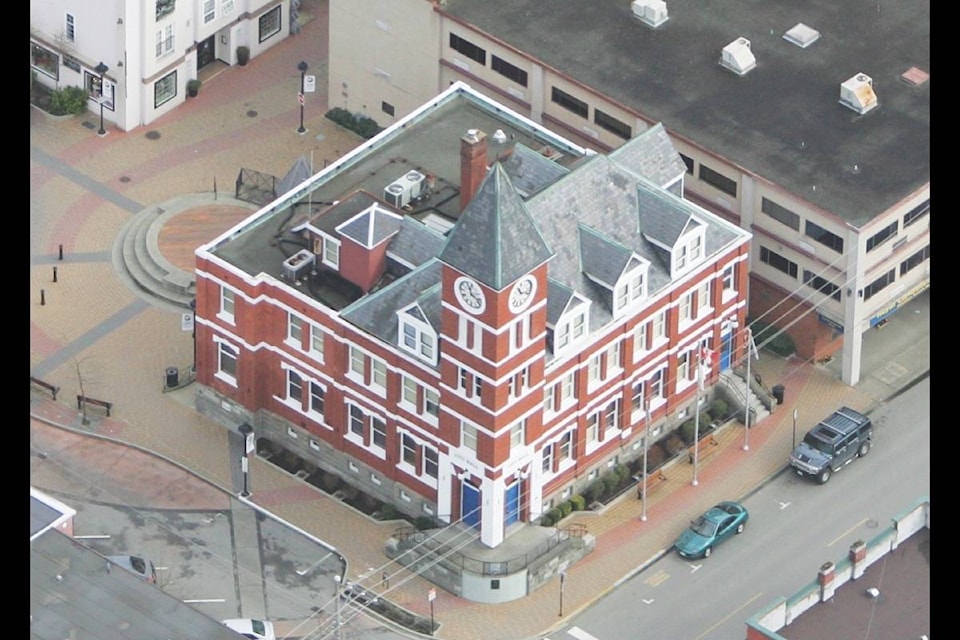“That Duncan is rapidly going ahead as the Chicago of Vancouver Island, the new post office is another proof…”—Cowichan Leader.
In 1908, city postmaster David Ford undertook to build, again on his own accord, Duncan’s fourth post office, also on Station Street.
Unlike its cottage-style predecessor, it was to be “thoroughly modern and up-to-date….[with] a floor space on the ground of about 50 x 70 feet [sic], and will be divided by partitions, one portion to be occupied as a store, the office portion [to be] fitted up in first class shape to handle the ever increasing [postal] business. Two hundred private boxes will be installed, and every convenience for the public benefit and comfort will be provided,” reported the Cowichan Leader.
“That Duncan is rapidly going ahead as the Chicago of Vancouver Island, the new post office is another proof, with the increase of population throughout the district and new capital coming in these modern improvements are necessary, and it is pleasing to know that staunch men like Mr. David Ford, our postmaster, has faith and enterprise enough to carry them out. There is a great future before our valley.”
Five weeks later, a progress report gave the correct dimensions: “Excavation for the basement and foundations of the new Post Office is being rapidly pushed by Mr. Walter Ford [the postmaster’s brother], who has the contract. The building, 50 x 52, will be divided in two, and one half will be occupied by the post office, which, by the way, will be a credit to the man who is having it built. It is very nicely laid out, will have lots of rooms, and will be fitted with all the most modern appliances for the handling of the mails and for the convenience of the public.
“The exact size [of the post office] will be 29 x 50 feet, and will give ample room; the other part of the building will be for rent as a store, and will be 22 x 50 feet, the upstairs portion will be fitted up for offices, etc.
“The building will be fitted with modern lavatories, and will be heated by a furnace in the basement, a large septic tank will be built, and everything will be completely in first class shape. The present building will be moved to the back of lot during construction… Our postmaster certainly deserves credit for his progressiveness and the people will, no doubt, appreciate the same.”
This fourth post office, later the home of Duncan Grocery, shared the building with the Tea Kettle Lunch, mail being sorted there until 1914 and the completion of the new post office at Craig and Kenneth (today’s City Hall), where Ford continued as Postmaster until his retirement.
As of 1942, what had been the third post office was yet in use, rented to Cowichan Bandmaster J. Tonkin. But it had to be demolished to prepare the site for the new two-storey concrete Hudson Building, budgeted at $6,416. Contractor Ford also had to haul away truckloads of carbide left from an acetylene plant used to illuminate the 1908 post office prior to electricity.
The Greenhaven Restaurant and Duncan Grocery appear to have been tenants in the combined 1908/1942 Ford/Hudson building(s). Byron Hudson thinks his father owned the restaurant from his arrival from Cumberland. The Greenhaven first appears in the Duncan phone book of the following year.
Hudson, who lived upstairs with wife Agnes, seems to have sold the restaurant to S.R. Kirkham in 1947, perhaps to concentrate on managing Hudson’s, formerly Hattie’s Hardware, until 1963.
It’s quite likely that Walter Hudson renovated in 1942 because of damage caused by a fire in February 1941, in the basement adjoining Duncan Grocery. The aging building — described at the time as being one of the “old wooden buildings which are considered [to be] the city’s greatest fire hazard” — was initially thought to be a goner.
But, within half an hour, firemen had the upper hand and averted what could have been disaster. Chaster thought the culprit to be the sawdust-burning furnace. Even E.P. Philip’s Billiard Hall, also in the basement, was soon back in business.
When disaster struck again on Valentine’s Day, 1960, only about 15-30 per cent of the original building was left standing. Extensive repairs and upgrades gave the structure the more modern appearance it has today and greater square footage, the east wall having been extended.
The lack of building permits and other records can leave researchers guessing. In this case, Priscilla Lowe, former curator of the Cowichan Valley Museum, concludes: “The [Hudson] building has its beginnings as the 1908 Post Office building owned by David Ford, to replace the small wooden building which was the previous post office building, the small building then being pushed back behind the new building and demolished either in the mid-40s or early 50s.
“The Hudson Block continued to show this 1908 connection clearly until the 1960 fire which was extensive. The building does not seem to have been totally demolished but massively renovated, the building enlarged and the exterior changed. There is probably very little of the 1908 building left but there must be some.”
